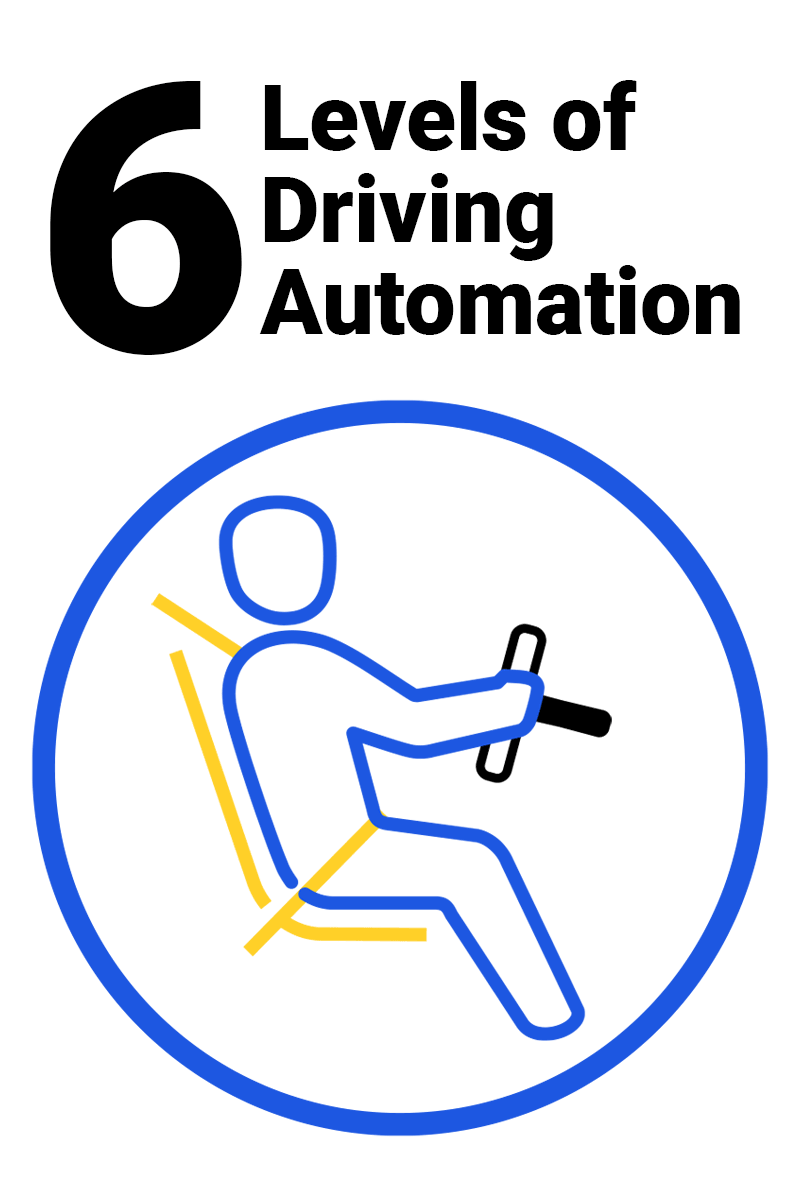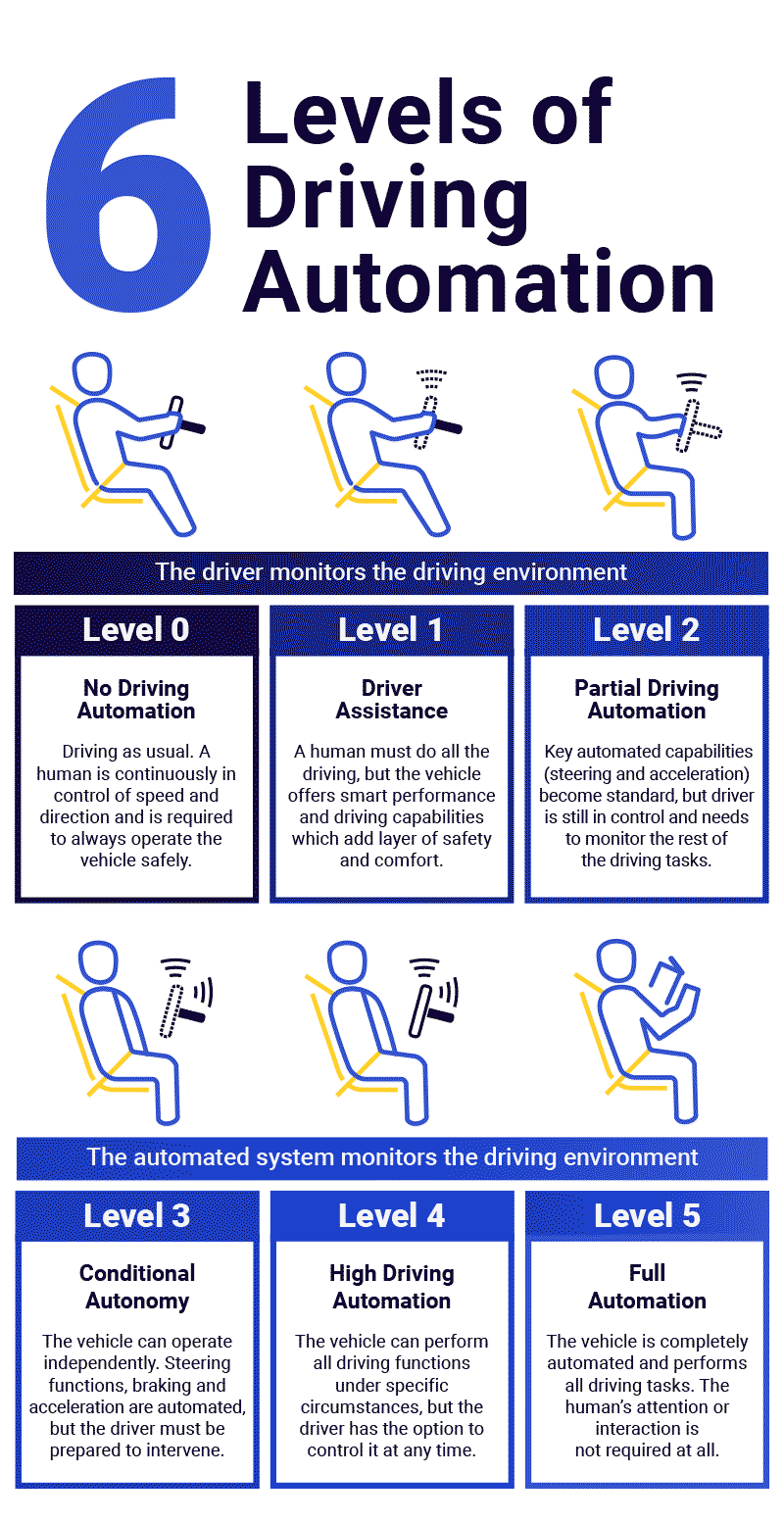Formerly known as the Society of Automotive Engineers, SAE International is a global professional association and standards organization. SAE International focuses primarily on global transport industries such as aerospace, automotive, and commercial vehicles. In 2014, SAE International created the following six levels of driving automation which have since been adopted by the U.S. Department of Transportation
 Autonomous vehicle technology leverages a combination of AI-powered algorithms, specialized cameras, and sensors to navigate and drive. These typically include lidar, radar, sonar, GPS, and inertial navigation systems. Self-driving cars analyze the data generated by these sensors to plot navigational paths and react in real-time by stopping, speeding up, slowing down, and avoiding objects.
Autonomous vehicle technology leverages a combination of AI-powered algorithms, specialized cameras, and sensors to navigate and drive. These typically include lidar, radar, sonar, GPS, and inertial navigation systems. Self-driving cars analyze the data generated by these sensors to plot navigational paths and react in real-time by stopping, speeding up, slowing down, and avoiding objects.
Level 0: No driving automation
At Level 0, vehicles completely lack any driving automation technology. The driver is always engaged, and entirely responsible for operating the vehicle. This includes steering, accelerating, braking, parking, and any other necessary maneuverers or actions to drive or halt the vehicle.
Some Level 0 vehicles may offer limited or momentary driver assistance features, such as warnings and alerts, or even emergency safety interventions. However, these are not considered autonomous functions—so drivers must remain fully attentive and engaged. Examples of limited or momentary driver assistance include automatic emergency braking, forward collision warning, and lane departure warning.
Level 1: Driver assistance
At Level 1, automotive systems provide continuous assistance with acceleration, braking, or steering. Specific examples of Level 1 driver assistance technologies include adaptive cruise control and lane keeping assistance.
Level 1 driver assistance systems operating individually aren’t considered autonomous technology by either the SAE or US National Highway Traffic Safety Administration (NHTSA). However, adaptive cruise control and lane keeping assistance systems operating simultaneously qualify as Level 2 automation.
Both Level 1 and Level 2 technology require drivers to remain attentive and fully engaged when operating a motor vehicle.
Level 2: Partial driving automation
At Level 2, vehicles provide partial automation by continuously helping drivers with acceleration, braking, and steering. Level 2 vehicles are typically equipped with advanced driver assistance systems (ADAS) that can take control—in specific scenarios—over the above-mentioned functions.
In 2014, Tesla Motors announced its first version of Autopilot, which later expanded to support autonomous steering, braking, speed adjustment, and parking capabilities. In October 2020, Tesla rolled out the first version of its full self-driving beta (FSD Beta) software and continues to release updates at a steady cadence. Despite the introduction of additional features, Tesla’s Autopilot is still classified as Level 2 partial driving automation technology.
The Highway Driving Assist system is another example of real-world Level 2 partial driving automation. Highway Driving Assist systems are installed in vehicles manufactured by Genesis, Hyundai, and Kia. Although these cars require drivers to keep their hands on the steering wheel, the driving assist systems actively steer, accelerate, and brake when traveling on highways.
BlueCruise—a new hands-free partial driving system from Ford—is a third example of real-world Level 2 partial driving automation. BlueCruise allows drivers to take their hands off the steering wheel on certain approved highways in the United States and Canada.
Level 3: Conditional driving automation
At Level 3, vehicles autonomously handle all driving tasks. However, drivers must always be available to take the wheel if ADAS requires assistance or suddenly stops functioning effectively. Level 3 conditional driving automation systems have been developed by several major automotive companies, including Audi.
Although Audi never received approval for its traffic assistance technology, Honda managed to successfully sell a Level 3 traffic jam assistance system. Limited to Japanese roads and the Legend flagship sedan, the system was rolled out to drivers as an optional and paid upgrade.
In early 2022, Mercedes-Benz announced plans to introduce Level 3 autonomous driving capabilities in the U.S. Dubbed Drive Pilot, the technology—which was recently approved for use on certain German highways—supports speeds up to 60 kph (37 mph) and can be used to semi-autonomously navigate in heavy traffic or traffic jams. If approved, drivers will be able to take their hands off the steering wheel and stream videos, send e-mails, and communicate with colleagues.
Level 4: High driving automation
At Level 4, autonomous vehicle systems are completely responsible for all driving and navigational tasks. These self-driving cars can autonomously transport passengers who do not need to be engaged or ready to take control of the vehicle.
However, Level 4 high driving automation systems are typically limited to specific geographic locations—and cannot travel outside of designated service areas or during dangerous weather conditions. Level 4 high driving automation is particularly well suited for driverless taxis and buses on designated routes, trucks transporting goods within specific geographic boundaries, as well as airport passenger and cargo (luggage) shuttles.
Level 5: Full driving automation
At Level 5, autonomous vehicles take full control of all driving and navigational tasks. Passengers simply set a destination and can work, sleep, watch movies, and play games. In the future, vehicles equipped with Level 5 full driving automation systems will operate independently and universally in all weather conditions and roadways.
Infographic

What level of autonomy do most vehicles have now?
Most cars and trucks on the road today feature limited levels of autonomy that span Levels 0 to 2. However, automakers have already announced Level 3 autonomous driving cars—and are working to develop and deploy Level 4 self-driving trucks as well as commercial robotaxis. According to Accenture, vehicles with full-on self-driving capabilities could start hitting highways as early as 2030.
Self-driving cars reduce the risk of accidents and collisions by implementing safeguards, alerting drivers, and taking full control of a vehicle if necessary. Moreover, self-driving cars automatically detect and react to other vehicles, bicyclists, pedestrians, construction zones, potholes, traffic accidents, and traffic jams. Perhaps most importantly, self-driving cars enforce safety standards that may be deliberately or accidentally ignored by human drivers.
Additional Resources:
– Other blogs around automotive & security:
- Automotive Security: Protecting vehicle electronic systems
- Connected vehicles face cyber terrorism threat
- Autonomous Vehicles: Everything about self-driving cars explained
- AI Requires Tailored DRAM Solutions: Part 2

Leave a Reply